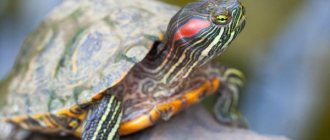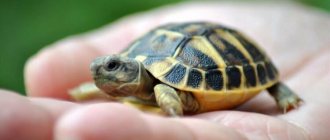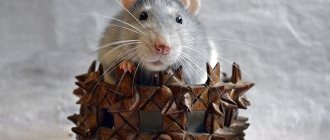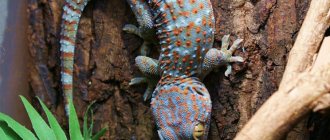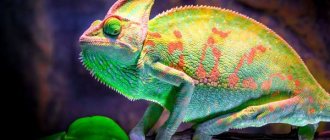Pet turtles are one of the most popular terrarium animals.
They are quite comfortable as a pet that every family member will love. There is an opinion that these reptiles are unpretentious in care. But in order for the animal to feel comfortable, be healthy and make you happy, you need to know as much as possible about it.
How to keep a turtle in the house? What do they like? How to create favorable conditions for caring for a turtle? In our article you will find all the necessary information.
Rules for the care and maintenance of pet turtles
Since there are aquatic and land turtles, caring for them is somewhat different. It is easier to care for a land turtle than an aquatic one, but the principle is the same. To make a land turtle feel comfortable, you need to have:
- Terrarium or spacious clean box.
- Availability of varied food.
- Take a warm bath once a week.
- Constant trimming of claws and beak.
As for the aquatic turtle, for its normal maintenance it needs to constantly have water, and therefore it has to be kept in an aquarium. Moreover, in the aquarium you need to arrange a place where the turtle can eat and rest.
Habitat arrangement
The reptile takes a long time to get used to new environmental conditions. To make the adaptation process easier for her, think in advance and buy everything you need to keep and care for your turtle at home.
You will need:
- Container - terrarium or aquarium.
- A small house where the animal will sleep and hide.
- Heating lamp.
- UV lamp.
- Containers for food and water.
- Thermometer.
- Substrate.
- Caches.
A waterfowl reptile needs a separate aquaterrarium with a capacity of about 100 liters. Water should take up most of it. Red-eared turtles require a space of more than 200 liters.
Additionally, a filter is installed. Turtles excrete a lot of waste products, and unfiltered water will be very dirty. Change at least 20% of the fluid every week.
Tap water is purified from chlorine and heavy metals before use. Add special conditioners to the terrarium liquid - they will neutralize turtle feces.
Use a heater to maintain the water temperature at 25-28 ºС. If it is cold, the animal will become lethargic, its metabolic processes will slow down, and there will be problems with digestion.
This condition is unacceptable - it leads to the death of the turtle. To maintain the desired temperature, install a thermostat in the terrarium.
Equip a separate area of land with a bridge where the animal can get out of the water. The island should be comfortable and smooth. Place a UV lamp on it.
Ultraviolet light promotes the release of vitamin D, without which calcium cannot be absorbed. A deficiency of this element leads to rickets, a fragile shell.
The temperature of the island of land should be 30-32 ºС. Turn off the UV lamp and heating at night.
Place stones the size of the turtle's head or larger at the bottom of the terrarium so that it cannot swallow them. Decorate your reptile's home with artificial plants - the living ones will be eaten. Use primer solely for aesthetics.
If you have a land turtle, it is advisable to choose glass housing for it. But a wooden box will also work if one side is transparent. The conditions in it - filling, lighting, additional elements - should be close to the natural environment.
Make sure there is good ventilation. The holes should be located at different levels on opposite sides of the terrarium.
Cover the bottom of your pet's home with hay. It is easy to change, it is comfortable to lie on, and the animal will not be able to swallow straws, which cannot be said about sand or small pebbles.
You can only use large pebbles on which the turtle will sharpen its claws. Corn mulch or cellulose filler is also used as bedding. They are easy to clean and a turtle can happily burrow into them.
Build a sleeping place from a plastic flower pot cut in half or use a wooden house for rodents.
Securely secure the feeder and water bowl. The turtle should not turn over “kitchen utensils” while walking around the terrarium.
Buy a mineral stone: the animal will chew on it and get extra calcium, and also sharpen the rhamphotec (beak). Install a heating lamp near the feeder and drinker; do not allow the air temperature to drop below 30ºC.
An ultraviolet lamp will imitate the sun's rays. The required power of the device is 10-12% UVB (UVB 200).
It's also worth knowing that reptiles transmit serious diseases, such as salmonella. Wash your hands thoroughly after direct contact with an animal.
Costs per turtle
If you decide to have a turtle at home, then you need to know and be prepared for the fact that you will have to shell out certain funds:
- Terrarium with additional equipment – 3000 rubles.
- Heating lamp – from 1000 rubles per six months.
- Feed costs – from 500 rubles per month.
- Examination by a veterinarian – from 1000 rubles.
As you can see from the list, the funds are not small, as for maintaining such a small animal. But that's not all: in addition to funds, she needs constant care and attention.
We weigh the pros and cons
Before you buy a turtle, think about the fact that we are talking about one of the oldest genera of reptiles. More than 220 million! Turtles have lived on Earth for years. They coexist peacefully with humans, but at the same time they never truly became pets.
Even after living side by side with you for a long time, turtles do not rush to see you when they meet you from work, and are happy that you pet them or scratch them behind the ear. You can only appreciate your pet's gratitude by observing its gradual increase in size. Not too much of a reward, would you agree?
Think about it, are you ready to take care of such a little emotional pet for years (turtles, as we remember, live quite a long time)?
If you are still determined and ready to adopt a turtle into your family, you must first resolve the issue of a place for the tortilla to live.
Feeding the turtle
For the normal development of a turtle, a varied diet is needed, including fresh vegetables (lettuce, cucumbers, cabbage, tomatoes, carrots, pumpkin), greens (dandelion, plantain, coltsfoot). At the same time, we must not forget that the turtle loves most - fruits (watermelon, melon, apple) and berries (strawberries, raspberries, cherries).
She is not averse to dining on cooled semolina or buckwheat porridge, and will also not refuse oatmeal prepared in the traditional way.
To prevent her from getting sick from a lack of nutrients, cottage cheese, boiled eggs, and raw minced meat should be added to the main diet. At the same time, there is no need to give her something to drink, since she gets most of her liquid from vegetables and fruits, and besides, she can drink while taking a bath.
The diet of an aquatic turtle is mainly meat and fish, but it will not refuse snails, worms, mice, etc. But this does not mean that she should not be given food of plant origin. It should be at least 30% in the diet of an aquatic turtle.
General information
Turtles are one of four orders of reptiles. These are the oldest and most primitive reptiles on earth. Today there are about 335 species in the world.
According to their habitat, reptiles are divided into marine and terrestrial. The latter species unites individuals living in fresh water and on land.
People eat their meat, but some species of turtles can be poisonous. In the wild, reptiles lead a solitary lifestyle and only look for a mate before the mating season.
Freshwater turtles are often predators, while land turtles feed on plants. But sometimes both species include food that is unusual for them in their diet. It is noteworthy that baby freshwater turtles eat animals, and as adults they become herbivores.
Turtles became the first creatures to fly around the moon and return to Earth. In 1968, they were present on board the unmanned Zond 5 spacecraft.
In addition, turtles are one of the longest-livers among all animals on earth. There is evidence that the giant tortoise Aivata lived 250 years.
In captivity, the reptile's lifespan is about 150 years. She lives the same amount of time at home.
Therefore, you cannot choose a pet spontaneously and thoughtlessly, because this is a friend for at least several decades. Children quickly get bored with a long-lived animal, and adults will have to look after it.
Reptiles do not pose a threat to humans, which is why they have become one of the most popular pets.
Freshwater and small land animals are suitable for this role. For example, in Europe, Balkan, Mediterranean or Central Asian turtles are chosen for home living.
Before you decide to buy such a pet, you should know: this is not a typical animal that you can pet and let walk around the apartment, like a cat or dog. Turtles are more about watching than touching.
Reptiles do not have a constant temperature; they feel comfortable only under special lamps for turtles. They are not recommended to walk outside the terrarium, so this tank must meet all the needs of the animal.
Setting up a terrarium for a land turtle
Firstly, the terrarium must be spacious so that the turtle can move more, and secondly, it must be clean.
Unsanitary conditions are absolutely unacceptable here.
Optional equipment:
- Lamp for lighting and heating the recreation area.
- Ultraviolet lamp for irradiation.
- Flooring.
- A place to hide.
- Thermometer for temperature control.
For an aquatic turtle you will have to make an aquarium with partial dry land. Typically the ratio is: 3 parts water and 1 part land.
Conditions for a pet aquatic turtle
Basically, the recommendations for creating a comfortable microenvironment for a pet aquatic turtle are the same, but there are a few nuances that should be taken into account.
- It is not recommended to plant aquatic plants that can be uprooted.
- To provide space for digging holes and food bowls, fill the waterless part of the tank with sand or coconut fiber.
- Dwarf shrimps do a good job of cleaning the water part. To kill snails, you can throw crustaceans into the water.
Additionally you will need to purchase:
- decorative floating platform;
- external filter;
- water heater;
- oxygen pump.
Trimming claws and beak
A turtle's claws and beak can grow to such a size that it has difficulty moving and eating. In this case, you need to get sharp nippers and trim off the excess. To shorten a turtle's claw, it needs to be placed in the light, where the blood vessel will be visible. Having retreated 2-3mm from the vessel, you can bite off the claw. The beak is bitten off in small pieces until the turtle's jaws close.
As for aquatic turtles, in this regard it is somewhat easier with them, since they do not need such procedures.
Conditions for hibernation
During the cold season, many species, with the exception of young or sick turtles, hibernate, which can last from three to five months. During hibernation, reptiles consume virtually no food and reduce their entire metabolism to a minimum. This means that wintering can take place, for example, in a well-ventilated box with bedding, which must be stored in a dark and dry place. In this case, the temperature in the hibernation room should not be lower than +4° and higher than +10°
Decor
When everything necessary for the comfortable existence of a redfish has been purchased at your home, you decided that it would be a good idea to think about the aesthetic function of the terrarium, so that when you come home from work tired and exhausted, you can rest your soul while looking at the beauty of the underwater world of your aquarium.
Well, let's start decorating. The bottom of the aquarium can be laid with colored pebbles
It is important to remember that the size of each pebble must be larger than the head of an adult turtle, otherwise the reptile may swallow it and choke, the consequences will be serious, even fatal.
It is better to choose plastic plants for the aquarium, since red-eared turtles, despite their predatory nature, are always not averse to snacking on a leaf of algae. The artificial algae themselves should be firmly fixed in the ground so that the playful turtle does not dig them up with its sharp claws.
A great solution would be to decorate the terrarium with various driftwood, clay houses or even caves. This will add beauty and mystery to the aquarium, creating the illusion of a real seabed. You can put a model of a sunken ship covered with algae on the bottom, however, it is worth remembering that any part of the interior in the aquarium should not have sharp parts, otherwise your pet will be injured. You can put a mineral block in the aquarium, which will help to naturally purify the water.
It is important to remember that it is better to take old wood snags, that is, those that have lain under water for a long time - fresh wood can release substances dangerous to reptiles
The sushi island can be made of stone, or you can install a plastic one, but cover it with pebbles so that the turtle’s paws do not slide on its surface. The height of the island should be such that your pet cannot crawl out of the aquarium and hide in an unknown direction.
Water
To successfully keep a red-eared turtle, the water temperature should not fall below +20 ºC, the most optimal parameter is +22+28 ºC.
The turtle spends almost all its time in water, so care should be taken to ensure that the water is clean. Animals sleep, eat and defecate directly in the water, so it needs to be changed frequently. A filter must be installed in the aquarium.
In a dirty aquatic environment, pathogenic microorganisms develop that cause various infectious diseases of turtles, which are then difficult to cure.
The water level in the aquaterrarium should be higher than the size of the turtle's shell. This is done so that an animal that accidentally ends up on its back can easily roll over on its own.
Normal development of red-eared turtles is possible only if good conditions are created for them. The turtle becomes a beloved pet, so you need to take care of it accordingly.
The optimal volume of liquid in the aquarium
The most optimal water level is considered to be filling the aquarium by half or two-thirds of the volume. It should be taken into account that the water should cover the reptile's shell by half. The water temperature should be kept between 26-30° C. This is the most favorable climate for the existence of individuals. You should monitor the cleanliness and freshness of the water and change it if necessary. But even with moderate contamination, it should be changed up to twice a month. Before filling the aquarium, it is advisable to test the water for chlorine content. Indicators should be minimal within normal limits. With increased concentrations of chlorine, small individuals may rub their eyes.
Rules for caring for an aquarium
The owner needs to organize proper care of the aquaterrarium, because the quality and lifespan of the domestic reptile depends on this.
Rules of care:
- Partial/full water change. Do not fill the tank with tap water. To keep reptiles you need clean, settled or filtered water.
- General cleaning, including washing glass, various accessories and appliances placed in the tank.
- Replacement and cleaning of soil.
It is also necessary to control the operation of filters, lighting devices and other devices that ensure a normal microclimate in the aquaterrarium for the healthy and comfortable life of the turtle.
How to keep aquarium turtles?
Keeping giant reptiles that live in ocean waters at home is problematic. In an apartment it is advisable to keep land species of creatures, their swamp counterparts or small reptiles that are accustomed to a freshwater environment. Keeping turtles in an aquarium cannot be called an extremely difficult task. Hobbyists need to know the basic rules for selecting soil and suitable containers for pets, be able to maintain the correct water balance and purchase good food.
How to set up an aquarium for turtles?
In order for a funny creature with a shell to delight its owner with its company for ten years or more, it is necessary to create suitable conditions for it. An ignorant approach leads to disappointment and death of the acquired reptile in a short period. Saving money and purchasing low-quality small containers is unacceptable in this matter. To keep large land creatures, enclosures with dimensions exceeding 250 liters are generally required.
What kind of aquarium is needed for a turtle:
- To calculate the capacity, use a formula where the length of the aquarium is determined by multiplying the length of the reptile by 7. The width of the tank is approximately two times less than its length.
- A small or medium-sized turtle will need a living space with dimensions of 60x40x50 cm, and a large creature or several medium-sized reptiles need an aquaterrarium with minimum dimensions of 120x50x50 cm.
- The minimum width of the aquarium must exceed 2 times the length of the reptile's shell.
- A 40-liter container is suitable exclusively for children; for them, purchase a vessel of an elongated horizontal shape with a height of 35 cm.
- Large aquarium turtles are considered to be those that reach 13 cm in length and require a living space of 150 liters.
- Amphibian species require coastlines for resting. Containers where water occupies 75% of the total volume, and the land area optimally matches the size of the shelled inhabitants, are best suited.
- Aquarium turtles should not touch the bottom while swimming. It is advisable to equip a vessel with a pool depth of 20 cm or more.
Filter for turtle aquarium
This device is necessary when arranging a container where aquatic species of reptiles will live. There are external and internal filters. The design of the external filter resembles a canister with a pump placed outside the tank. Its body contains several compartments filled with filter media. This device is connected to the aquatic environment of the aquarium using tubes. The advantage of external filters is that they do not occupy useful space inside.
Internal filters are smaller in size and look more modest. They are equipped with pumps and a diffuser, doing a good job of cleaning liquids. Water is filtered using a cartridge with a sponge, carbon or other elements. The structure is attached to the wall from the inside of the container at different angles. If you make a list of what a turtle needs in an aquarium, then the filter should be on the first line.
Caring for aquarium turtles
Aquariums and terrariums must contain soil, an artificial pool, a backlight lamp, and ultraviolet lamps. The ambient temperature in a warm corner reaches 30-40 degrees, depending on the type of reptile. Creatures from hot countries, like Libyan tortoises, are extremely thermophilic. Ultraviolet light is important for small aquarium turtles, the proper care and maintenance of which is impossible without vitamin D. UV lamps help the body absorb this element; if it is deficient, animals suffer from curvature of the shell and rickets.
The soil is made for aquatic creatures from gravel and fine sand. For land aquarium turtles, soil from the garden without impurities and chemicals and a coconut substrate are suitable. Reptiles often damage plant roots; you can plant them in pots or limit them to floating algae. Islands made of stones and decorative driftwood decorate aquariums well.
What to feed aquarium turtles?
When it comes to what aquarium turtles eat, they are not particularly demanding. Land creatures eat succulent and dry vegetation, pieces of vegetables, fruits, slugs, and caught insects. In aquariums they are offered leaves of fruit trees and grapes, lettuce, dandelions with alfalfa and clover. Aquatic species of reptiles eat shellfish, shrimp, snails, and pieces of beef. In addition to live food, sea turtles need plant foods - lettuce, cabbage and greens. Include vitamin supplements and minerals, eggshells, and bone meal in your pet's food.
What should the water be and how much should it be poured?
To keep a turtle comfortable, you need a swimming pool. The volume of water in it depends on the type of reptile. For land species, the depth of the reservoir should be only 0.5 times the height of the reptile’s shell. For the freshwater red-eared turtle and other aquatic species, a slightly larger volume is required, which would provide it with the ability to freely turn over with its shell down.
There should be no obstacles for the animal to swim in the pool.
You can use regular tap water for the aquarium, but you just need to let it sit for about 5 days first. This is necessary to evaporate chlorine from it. High chlorine content can cause eye and skin allergies in reptiles. Water should always be clean and fresh. There are water quality requirements such as:
- acidity (pH) in the range of 6–8, which corresponds to tap water;
- Water hardness can be any, but water with a higher carbonate content, a source of calcium, is considered more useful;
- optimal water temperature – +26–+30 degrees; At lower temperatures, the red-eared slider and other aquatic species become lethargic and inert and may even refuse to eat.
Which aquariums are not suitable for turtles?
Experts do not recommend buying an aquarium for red-eared turtles with a volume of 50-70 liters. Small aquariums have a bad effect on the development and growth of the animal. In small aquariums, the animal develops degeneration of the shell, it becomes soft, and the animal’s skin suffers.
The aquarium must have space for lighting, an ultraviolet lamp, and a filter. Without this equipment, the red-eared slider will get sick and die.
You cannot house red-eared turtles with fish. She will eat small aquarium fish. If you want to combine turtles and fish in one aquarium, divide it into two halves by installing a glass partition. The glass must have holes for water. Do not make large holes; the animal should not be able to crawl into the compartment with live fish.
Turtles grow quickly. Already in the first year of life, some individuals grow up to 35 cm in length. Keep this in mind when purchasing an aquarium. Take a reserve tank. There should be no dangerous objects in the equipped aquarium: no small stones, glass, completely eliminate plastic. You cannot leave the aquarium open; the animal may crawl out and die. Caring for turtles is not difficult, the main thing is to properly arrange its home. With proper care and design of the aquaterrarium, the red-eared turtle will live for many years.
Reproduction
In nature, animals begin mating in March and June, but at home they mate all year round. In good conditions, the female will lay 3-4 clutches of two dozen eggs per season.
Prepare a suitable nest for a pregnant female.
During pregnancy, the female spends more time on land, her need for calcium and UV rays increases.
Determination of gender
In most species, females are larger than individuals of the opposite sex. The cloaca is closer to the tail and has a star-shaped shape.
In males, the tail is longer, and the genital organ is located in it. Their claws are stronger, thicker, more curved; The plastron is curved, this helps with mating.
Red-eared sliders reach maturity within a year because they grow faster than other species. Sex can be accurately determined in males at the age of 2–4 years, in females – at 3–5 years. Then the size exceeds 10 cm. Read more about the field of red-eared turtles in a separate article.
In Central Asians, sex becomes obvious when the reptile reaches 6–10 years of age. You can distinguish a female from a male by the number of horny tubercles on the inner side of the thigh. The female has 3–5 of them, the male has one.
Handling babies
The immunity of small turtles is not strong, they are susceptible to disease, sensitive to living conditions, and have a high mortality rate. Observe the feeding of newborns, adapt their living environment.
For some time after birth, babies do not eat the food that is offered. They receive nutrition from the yolk sac on the plastron. Do not touch or remove it! When this sac resolves, the little turtle begins to feed as usual. The diet must contain food with a high calcium content.
Babies are very gentle, shy, and easily fall into a state of stress. Protect them from unnecessary worries, surround them with care. Do not pick him up unless necessary, do not stand over the aquarium, do not knock, do not make loud noise.
It is important to ensure a constant temperature for the cubs: for water 26–27 degrees and for air (land) 32 degrees. Keep the water clean, pass it through a filter, change it every two days.
Children of the red-eared turtle do not tolerate drafts or direct sunlight. Provide them with access to a place on land heated by a special lamp. Baby turtles are kept at warmer temperatures than adults.
Babies are bathed two or three times a week. The washing procedure for children is the same as for adults.
Fights and aggression
Red-eared turtles are active, strong and prone to aggression. They try to dominate the living space and attack turtles of other species and relatives, taking food from each other. They inflict wounds and bite.
If a new resident appears in the aquarium, this provokes fights among sexually mature individuals. Males attack females, causing serious injury or even death. This behavior is normal for this species of turtle.
Thoughtful care and maintenance helps reduce aggression in turtles. Try to enlarge the room where they live, set restrictions, barriers inside the aquarium so that they do not see each other.
Feed the animals one at a time behind the walls of the aquarium in a special dining area. Or keep each animal in a separate space. Red-eared turtles love solitude and live quietly without a mate.
UV lamp
Depending on the age of the turtles, the power of the UV lamp is selected:
- for young individuals – 5% UVB;
- for adults – 10% UVB.
The presence of an ultraviolet lamp is the main condition for the normal development of red-eared turtles. To prevent animals from getting eye burns, the UV lamp should be installed at a level of at least 25 cm and turned on for 10-12 hours, turned off only at night.
Ultraviolet radiation prevents the development of rickets, improves metabolism, and affects the activity of turtles. The rays help absorb calcium, which is necessary for building the shell.
Are walks good for you?
You can take your pet outside; it is beneficial for the reptile. But only if the weather is warm, dry and the air temperature is not lower than 25°C. The turtle will happily wander around the green lawn or lawn and breathe in the fresh air. It is important to choose a suitable area - calm, clean, where the reptile will be protected from overly curious or aggressive animals.
You should always watch it - despite the apparent slowness, these armored animals often run away from their owners. If the place turns out to be noisy, the turtle will hide and will not even show its nose from its shell. These pets love to feast on fresh herbs; you can let them go for a walk where dandelions, clover, plantain, timothy, and chamomile grow.
